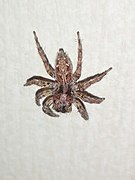|
Plexippus petersi
Plexippus petersi is a species of jumping spider native to Asia that has been introduced to Africa and Pacific islands.[1] The male is between 6 and 10 mm (0.24 and 0.39 in) in length, and the female is around 10 millimetres (0.39 in). This spider is commonly known as the tropical flycatcher[2] or small zebra jumper.[3] DescriptionThe male Plexippus petersi is between 6 and 10 mm (0.24 and 0.39 in) long and the female is slightly larger. The head bears four pairs of eyes, one pair is larger than the others, forward-facing and movable, while the remainder are small and fixed in position.[3] The cephalothorax is longer than it is wide and is brown with two darker reddish-brown bands on the dorsal surface. The abdomen is twice as long as it is wide and is yellowish-brown dorsally with two longitudinal darker brown bands which are broken posteriorly to give a pair of orangish spots on either side; the ventral surface is yellowish-brown and the spinnerets are greyish-brown. The pale parts of the abdomen are clad with whitish setae (bristles), and the darker areas are covered with brown setae. The legs are yellowish-brown, streaked with darker brown and darker near the joints, and have blackish-brown leading edges. There are scattered setae on the legs and the femur has a dense patch of brown hairs.[4] DistributionPlexippus petersi is native to Southeastern Asia. Its range includes Africa, China, Japan, Indonesia, New Guinea, the Philippines, Vietnam,[4] Laos,[5] Cambodia,[5] India, Sri Lanka, Malaysia and Australia.[2] EcologyPlexippus petersi is a house spider, living indoors, and admired for the skilful way it hunts and catches mosquitoes, flies and other invertebrates.[2] It has also been found living in crops in the Philippines, in one instance in a rice field infested with the armyworm Spodoptera mauritia, and in another, in a corn field attacked by the northern armyworm Mythimna separata.[4] This spider has been investigated as a control agent for houseflies and showed potential as a bio-control agent.[citation needed] GalleryReferences
|
||||||||||||||||||||||||||||||||||



